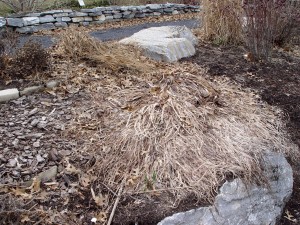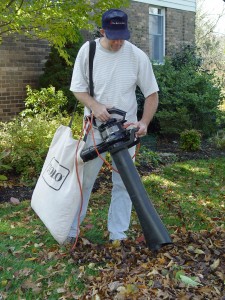Cleanup or Sanitize?
November 5th, 2013
Now that frost has ended another growing season (at least for the most part), lots of gardeners and yardeners are turning their attention to so-called “fall cleanup.”
This is where tradition has it that we’re to go out and rake every last leaf off the property, pull or cut those browned-out flowers, and basically do the outdoor equivalent of a spring house-cleaning.
Out come the leaf blowers, rakes, pruners, power shears, plastic bags and yes, even lawn vacs to cleanse the yard of anything that’s seen better days.
At least it’s good exercise. But it’s also overkill and, in some cases, counter-productive.
While some of this work makes good sense and is well timed, there’s a big difference between “putting the landscape to bed” and sanitizing the entire outside.
Here’s a rundown to help you separate your fall “honey-do list” from the “honey-don’t list:”
Lawn Leaves
Honey-Don’t: Don’t automatically rake or blow lawn leaves out to the curb, or worse yet, stuff them in plastic bags for the landfill.
Honey-Do: Run over light leaf coverings with your mower and let the fragments lie. They’ll decay and add nutrition and organic matter to the soil.
Too many? Add them to your compost pile or use them as mulch in shrub beds and vegetable gardens (preferably chopped first). Move them to the curb as a last resort, not a first.
At least municipalities now recycle the leaves back into compost, but you’re paying a fair chunk of tax dollars for the service.
Leaves in Beds
Honey-Don’t: No need to rake fallen leaves out of most landscape beds. They’re great for insulating the roots of perennial flowers and shrubs, for weed control next spring and for adding organic matter to the soil as they decay. (Earthworms will thank you, too.)
Honey-Do: Remove only leaves that are covering evergreen plants and groundcovers (spreading junipers, pachysandra, vinca, etc.) Excessive leaf buildups elsewhere can be dealt with in spring, and the rest can be lightly mulched over for those who like those neatly “tanbarked” beds.
Pruning
Honey-Don’t: Now’s not an ideal time to shear or prune any of your trees, shrubs and evergreens. Yeah, things look like they need it, but plants are just now going dormancy.
Evergreens will look bare and chopped all winter if you whack them now, and you’ll cut flower buds off the spring-blooming shrubs by pruning in fall or winter.
Honey-Do: At least wait until the leaves drop to prune deciduous trees and shrubs. End of winter and spring are better. Then you can deal with any winter- or deer-injured wood at the same time.
Wait until immediately after bloom to prune anything that blooms in March, April and May (azaleas, rhododendrons, forsythia, lilacs, etc.)
Perennial Flowers
Honey-Don’t: Don’t think you’ve got to cut every last perennial flower to the ground before snow comes. Many perennials — mums in particular — benefit from the insulation given by browned-out top growth that collapses around the roots.

This cluster of kniphofia at winter’s end will come up a lot easier than cutting it back in early fall before it’s collapsed.
Honey-Do: By all means, get rid of browned-out foliage that’s diseased or bug-ridden. That can help short-circuit a re-infestation next year.
But let healthy, frost-killed foliage stand — especially varieties with seeds favored by over-wintering birds (black-eyed susans, coneflowers, sedum, etc.) Clean out this foliage next spring before new growth begins.
Also let alone perennials that are still green. They add interest to the winter garden and can be neatened at the end of winter, if needed. A few perennials are truly evergreen and don’t need annual cutbacks (dianthus, yucca, creeping sedum, ajuga, etc.)
Lawn Care
Honey-Don’t: Don’t automatically lime the lawn unless a soil test confirms you actually need it. Excess lime is at best a waste of time and money and at worst counter-productive to lawn health.
Honey-Do: A season-ending dose of fertilizer is usually a good idea (just get it down before the ground freezes). Cutting short (about 2 inches tall) for the last time can head off fungal disease early next season.
Tilling
Honey-Don’t: Good gardeners are supposed to “clean up” the vegetable garden and flower beds by tilling every fall after everything is yanked. Research shows, however, that that increases weed problems, speeds up the loss of organic matter and can harm soil composition — especially when tilling is done in wet soil.
Honey-Do: Go ahead and yank the dead stuff. Toss bug- and disease-infested plants but compost the rest. Then just layer an inch or so of compost, mushroom soil, chopped leaves or similar organic matter over the surface.









